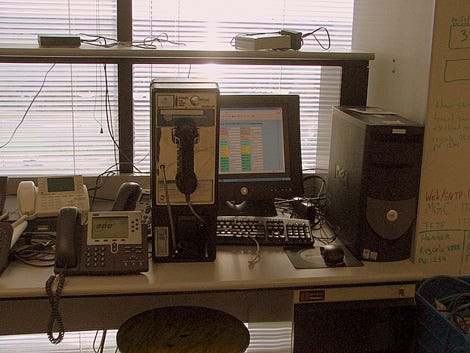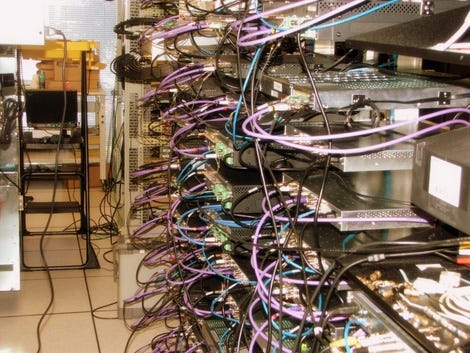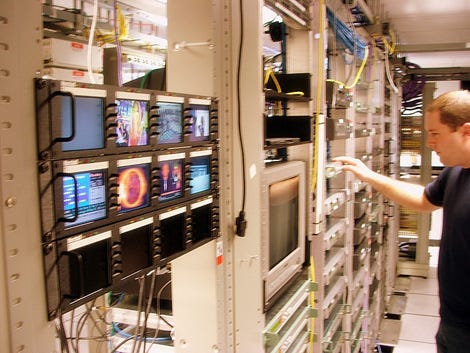Inside SBC's IPTV Factory
A look into its labs shows how far along SBC's come in its quest to roll out IPTV to 19 million homes
March 7, 2005

AUSTIN, Texas -- Judging from the workings deep inside SBC Communications Inc. (NYSE: SBC) labs, it's clear the service provider is serious about Project Lightspeed, its IPTV service.
Last fall, the company said it wanted to reach 18 million households with super high-speed data, video, and voice services in two to three years, rather than the five years it first predicted (see SBC Speeds Up FTTH Plan). This week, the company upgraded its plans to include 19 million homes -- providing each home with connections as fast as 20 Mbit/s or 39 Mbit/s, depending on the location.
Despite spending $4 billion to upgrade nearly half its network in three years, SBC's executives don't seem worried about making the goal. "I don't lose sleep over this project," says SBC executive vice president Lea Anne Champion, who spoke here to the DSL Forum last week. While SBC's IPTV service isn't ready to roll just yet, all the moving parts are coming together quickly, as revealed by Light Reading's exclusive tour of SBC Labs last week (week of March 1).
While SBC's IPTV service isn't ready to roll just yet, all the moving parts are coming together quickly, as revealed by Light Reading's exclusive tour of SBC Labs last week (week of March 1).
Here's a roundup of what we saw and heard:
Buy me a backbone: SBC's acquisition of AT&T Corp. (NYSE: T) takes on a new significance in light of SBC's IPTV plans. Champion says SBC's video distribution network contains two national content aggregation centers (master headends), one in Los Angeles and one in the Midwest; 40 IP video hubs (regional headends); and 140 IP video serving offices (local distribution points).
So where does AT&T's network come in? Video content is collected at the master headends, converted to IP data streams, and sent around the country. At the regional level, local channels, commercials, and other programming are added. At the local level, the streams are collected until a channel request is made by a subscriber. This all requires lots of bandwidth, with lots of connectivity on a national level.A compression question: SBC won't use MPEG2, the compression technique for video most commonly used by cable and satellite providers, in its IPTV system. It is aiming to use either Microsoft's proprietary Windows Media 9 codec, which comes with its own Digital Rights Management (DRM) capabilities, or MPEG4, which requires a third-party DRM vendor.To distribute one channel of high-definition video, a network needs about 20 Mbit/s of bandwidth for MPEG2, 5 Mbit/s to 8 Mbit/s for Windows Media 9, and 6 Mbit/s to 7 Mbit/s for MPEG4. SBC says it will provide 6 Mbit/s to 8 Mbit/s per HD channel.SBC hasn't specified how it will use DRM in its IPTV system, but, according to Dinesh Nadaraja, a lead member of the technical staff at SBC Labs, DRM can protect content rights and allow networks to block consumers from fast-forwarding commercials when they watch content saved on a digital video recorder [ed. note: now, there's a welcome leap forward for humankind].

Your TV: The fact that the TV content is IP-based allows for personal content customization as well. One concept SBC demonstrates in its labs is a baseball game in which the screen can be subdivided like a Web page with different camera angles, player statistics, and a game box score in addition to a feed of the (oh yeah!) game itself. Another idea is that consumers could generate their own TV channels to which others can subscribe. This could be used, for example, to broadcast photo slideshows and home movies to friends and family.
Watching you watch TV: SBC's Human Factors Lab -- a research area where consumers are observed in realistic settings behind two-way mirrors -- was instrumental in finding what IPTV resolution would be pleasing to consumers. Using EchoStar Communications Corp.'s service as "the gold standard", the lab worked with consumers to analyze several levels of video quality and state their preference.
SBC said the Human Factors Lab helped the service provider build its DSL self-install kit for consumers -- a breakthrough that saves the carrier $425 million a year in truck-roll costs, according to Jeff Brandt, a principal member of the technical staff at the labs.

Redmond conspiracy: Microsoft Corp. (Nasdaq: MSFT) appeared to come from out of nowhere to win SBC's IPTV middleware business, but the carrier says it wasn't a quid pro quo arrangement. SBC spokespeople say there was a real bidding process between Microsoft and three other contenders and the vetting process lasted "a few weeks." SBC insists it has observed Microsoft's IPTV software in working networks and tested the software thoroughly before committing.

Media consolidation is good: SBC has negotiated its own distribution rights with content providers rather than buying channels through a channel aggregator, such as the National Cable Television Cooperative Inc. "It wasn't that difficult," says Champion. "Eighty percent of the channels come from about six companies." SBC won't yet say what specific content it intends to offer, however.
A different kind of executive trial: SBC executives in San Antonio have been testing the carrier's IPTV service for 45 days or so. The service is being fed from Austin, where five local San Antonio channels are being fed from Echostar, compressed with Windows Media 9, and sent via optical link to SBC's San Antonio offices. More fleshed-out residential trials for IPTV will begin in April.
When complete, Project Lightspeed will still only cover about 50 percent of SBC's territory. For those areas left out of the Lightspeed range, SBC has mentioned the rollout of a product called "Home Zone" -- an assembled bundle of voice, video, and data services. Home Zone subscribers will see some convergence, too. No, their services won't come down a single wire, but they will arrive on the same bill.
— Phil Harvey, News Editor, Light Reading
You May Also Like


_International_Software_Products.jpeg?width=300&auto=webp&quality=80&disable=upscale)







